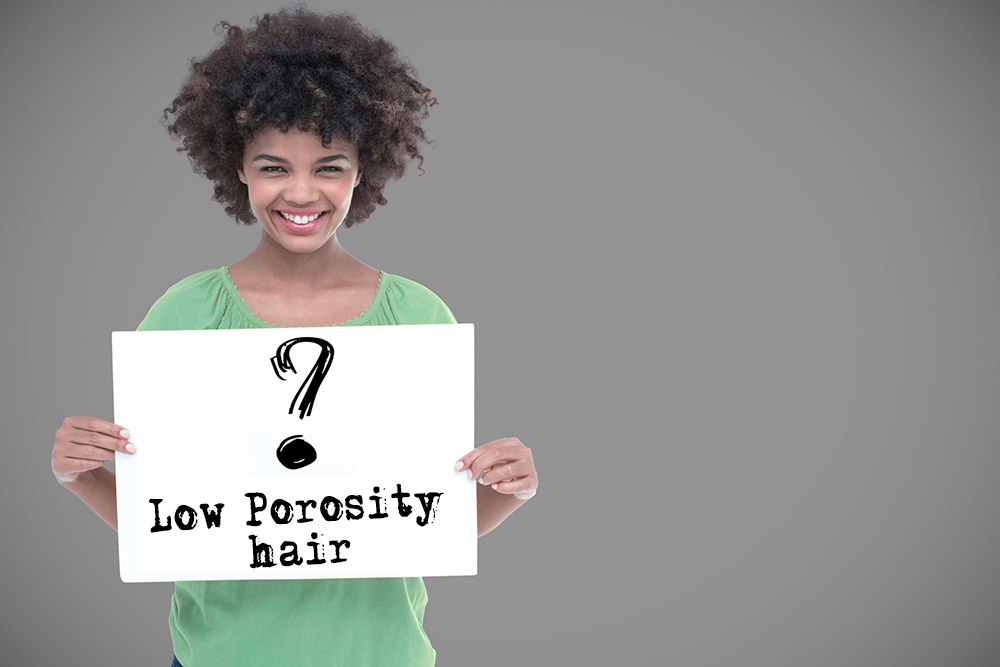Low Porosity Hair – What is Low Porosity Hair?
Understanding your hair porosity, especially if you have low-porosity hair, is key to a thriving natural hair journey.
Discover the secrets to unlocking your hair’s full potential!
Let’s dive into all things low porosity hair!
*Pssst, for a comprehensive list of all the natural hair lingo to know when you embark on your exciting Journey, NaturalHairZone.com’s Natural Hair Glossary can bring you up to speed on the top 50 natural hair buzz words.
1. What exactly is Hair Porosity?
Your hair porosity = The ability of your hair to absorb and maintain moisture.
Think of a material with either large or small holes. If it has large holes, then it is highly porous and it is easy for water to run out of it. If, on the other hand, it has smaller holes, than it can retain water for longer.
In essence hair porosity is all about how easily hair can absorb and retain water.
2. Why is Hair Porosity so Important?
Knowing your hair porosity as a Type 4 Natural is extremely important because it goes to the root of any length retention goals.
If you want long natural hair, you need to be able to keep it moisturised to prevent breakage, unnecessary tangles and shedding.
High Porosity
Hair with high porosity can absorb the most moisture into the hair strands but also, by the same token, loses this moisture quickly.

This is the ‘easy come, easy go’ porosity type – and a main characteristic of this hair type is excess frizz.
Unless properly managed, this porosity type’s main challenge is retaining moisture.
Low-Porosity Struggles to Absorb Moisture
On the other hand, low-porosity hair does not absorb moisture into the hair strands easily.
The plus side is that when it does absorb the moisture, it can retain it for longer, keeping hair soft and supple for longer.
Why Understand Porosity?
It goes without saying that one of the reasons why understanding one’s hair porosity is keyis because it ensures that your hair stays hydrated for longer.
Hydrated, moisturised hair is easier to style, maintains sheen and is less likely to break – making it easy to achieve your hair length goals.
Do you struggle with Thinning Hair?
3. How do I know my Hair Porosity?
There are three different ways in which you can determine your hair porosity:
The Float Porosity Test
Step 1 – Pluck a Strand of Hair
Pluck a strand of hair from your roots (or your comb, as long as it is an unbroken strand from your roots) and drop it in a glass of water.
Step 2 – Drop into a Glass of Water & Observe
If the hair strand absorbs the water straight away and sinks to the bottom, you have high porosity hair.
If it floats on top for a while before sinking, then you have low porosity hair.
Alternatives to the Float Test
If you are not keen on plucking whole strands of hair, you can give the float test a pass and try the feel porosity test.

The Feel Porosity Test
The Feel Porosity Test is a porosity test that requires you to feel your hair.
Take a single strand of hair and slide your finger up and down, along the strand.
If you feel little bumps along the hair shaft, then it means that your cuticle is lifted and you have high porosity.
If your fingers slip smoothly along the hair strand, then it means that you have low-porosity hair.
The NaHaZo Porosity Test
The Na Ha ZO Porosity Test is a quick question-and-answer porosity test.
Based on your experience caring for your hair, you can assess and ask yourself a few basic questions.
Should you answer yes to most of these observations, then you are most likely a low-porosity natural:
- Your hair strands dry slowly;
- Products tend to sit on top of your hair shaft and are not easily absorbed without manipulation (read heat);
- Your hair takes a while to get fully saturated with water when you wash it;
- You do not need to have regular protein treatments; and
- Products with keratin/protein harden your hair.
Alternatively, if you tick yes to these observations, you are mostly a high porosity natural:
- Your hair strands air dry quickly;
- Products are easily absorbed into your hair;
- Your hair gets wet easily; and
- Your hair frizzes easily.
Once you know your hair porosity, the next step is to determine what products suit your hair type.
Find out more on the LCO and LOC Methods for Black Hair Texture.
4. The Correct Regime for Low Porosity Hair
To get the best out of low hair porosity hair, you should incorporate the following hair practices in your hair routine.

Clarifying
Clarify your hair often to remove any build-up.
Excessive build up makes it harder for moisture to penetrate low porosity hair stands.
ACV Rinse – Regularly Depending on the Porosity of your Hair
Regularly use ACV rinse and Clay masks to cleanse your hair and scalp. You can also invest in a good clarifying shampoo.
Regular Deep Conditioning Treatments
Heat slightly lifts hair cuticles, allowing water absorption.
You can do deep conditioning treatments bi-monthly or once a month, depending how dry your hair strands are.
Also, be sure to rinse your hair with warm water.
Humectants and Emollients are Important
Use Humectants and Emollients.
Introducing humectants and emollients into your hair regime is important.
Humectants are great as they aid in trapping moisture onto your hair shaft and draw in moisture from around – keeping your hair strands hydrated.
Great humectants include glycerine, honey, molasses, castor oil, and Shea butter.
5. Limit Protein Treatments
Regular protein treatments are not advisable for naturals with low porosity hair. This is because these treatments tend to make hair more prone to dryness.
Rather do protein treatments as and when needed, or you can keep the treatment on your hair for shorter periods.
Catch up on all things Type 3C Naturals?
Armed with these gems of wisdom, your hair growth goals should be attainable, as well as a healthier sheen and look to your hair.
How has knowing your natural hair’s low-porosity impacted your natural hair journey Share your experience with us below.
Until the next time, happy naturaling Ladies!









